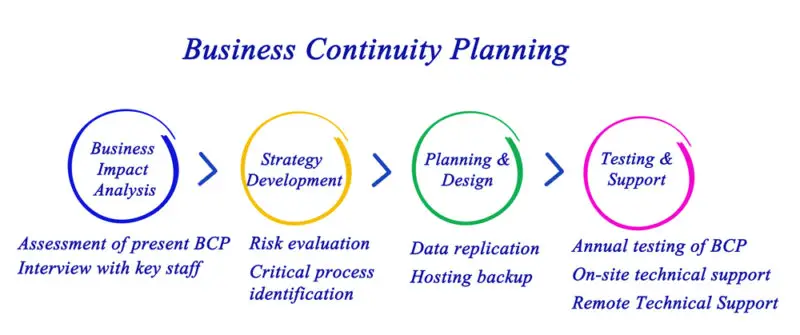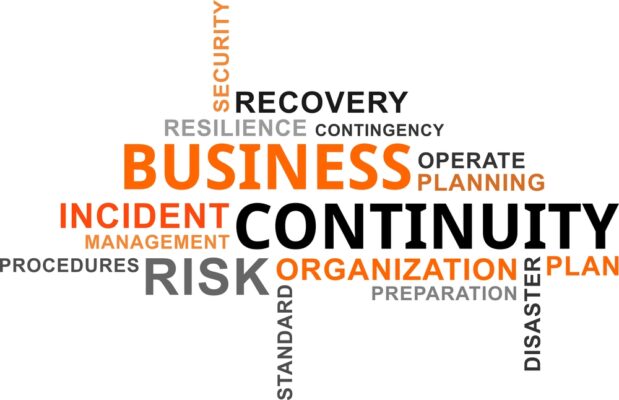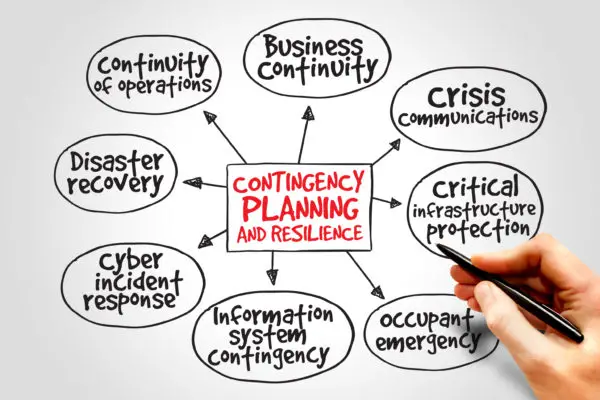Business Continuity Planning, or BCP, is like a game plan companies create to keep going when unexpected problems happen.
It’s about figuring out what could go wrong, protecting against these issues, and having a clear plan to get back on track quickly if something disrupts the business.
BCP is important because it helps a company bounce back fast and keep doing the most important parts of its work.
This article will discuss what makes up a good BCP and why it’s valuable, especially when the business world is always changing.
For example, if a natural disaster strikes, a company with a solid BCP would already have a backup location to work from and a system for communicating with employees and customers.
They might also recommend specific software solutions, like cloud storage services, to ensure data is not lost and can be accessed anywhere.
This kind of planning is key because it means a business can keep serving its customers without a big break or loss of income.

Definition of Business Continuity Planning
Business Continuity Planning (BCP) is a process that helps a company keep running even when serious problems happen.
It’s about figuring out what could go wrong and making plans to deal with those issues so the company can keep going and protect the people and things that are most important.
For example, if there’s a natural disaster, a good BCP might include having a backup location for the office so work can continue.
This planning is key to ensuring a company can handle tough times and keep its customers and employees from facing problems.
Purpose of Business Continuity Planning
Business Continuity Planning (BCP) is a company’s game plan for dealing with emergencies.
It helps ensure the business’s most important parts can keep running, even when unexpected problems happen. Here’s what it involves:
- Analyzing the Impact: It’s about figuring out which parts of the business absolutely must keep going and understanding how a disruption could affect them. For example, a company might look at how a power outage would stop production in a factory and plan for that.
- Making a Recovery Plan: This step is about setting goals for getting things back to normal and having a clear plan to get there. For instance, a business might decide to get its customer service up and running within two hours of a power cut and have generators in place to make that possible.
- Preparing for Crises: This means planning to keep people safe and secure the business’s assets when something bad happens. It includes things like knowing who will make decisions during an emergency and having a system to communicate with employees.
The goal of BCP is to make sure a company can face challenges head-on and keep doing what’s crucial for its success.
It’s about being prepared so the business and its customers don’t have to face the music when trouble strikes.
Components of Business Continuity Planning
Business continuity planning is about ensuring a company can keep going even when problems arise.
First, a company needs to figure out what parts of its business are absolutely necessary to keep running. Then, it needs to consider what could go wrong and how bad the effects could be.
After that, it’s time to devise a plan to deal with these problems and decide on clear goals for getting back on track.
It’s also important to have a team ready to handle emergencies when they happen.
For instance, a business might decide that keeping its customer service and shipping operations running is crucial.
If a natural disaster were to hit, this could disrupt shipping routes. The company’s plan might include having a backup warehouse in a different location or agreements with alternative shipping companies.
The goal could be to resume shipping within 24 hours of a disruption. To prepare for emergencies, the company would train a team in advance to know exactly what to do when the usual operations are disturbed.
Identifying Critical Functions and Operations
Figuring out the most important parts and processes of a business is a major step in planning how to keep a business going if something goes wrong.
Making a business continuity plan is about ensuring the most essential parts of a business can keep working, even during tough times.
Here’s what you need to do:
- List the Essentials: Find out what processes your business must have to keep going. Make sure these are the first to get back on track if there’s a problem.
- Check Connections: Look at how these important processes rely on each other, and note anything inside or outside the company that might affect returning to normal.
- Make Recovery Plans: Write out step-by-step plans to get these critical parts of your business running again. These plans should work together with any emergency handling and disaster recovery plans you already have.
Good planning means a business can react quickly and effectively when something bad happens, keeping the most important parts running smoothly.
Assessing Impact & Potential Disruptions
Evaluating how a business might be affected by unexpected problems is a key step in planning to keep the company running smoothly.
This evaluation looks closely at more than just money; it considers how the company’s main activities, customers, and communication during a crisis could be affected.
For instance, issues like supply chain breakdowns, extreme weather, and computer hacks require a well-thought-out plan to handle them.
Here’s a simple table that shows different types of problems, what they could affect, and ways to deal with them:
| Disruptive Event | Area of Impact | Mitigation Strategy |
|---|---|---|
| Extreme Weather | Day-to-Day Work | Plans for Working Remotely |
| Computer Hack | Keeping Data Safe | Strong Computer Safeguards |
| Supply Chain Problems | Getting Products to Customers | Using Different Suppliers |
| Health Emergency | Employee Health | Steps to Stay Healthy |
Analyze disruptions to prepare for quick resumption of operations.
In a conversation, you might explain it like this: Planning for tough times in business is like having an emergency kit at home.
You hope you never need it, but being ready is essential. For a business, this means figuring out what could go wrong, how it would affect everything, and having a plan to keep things moving.
For example, if a big storm hits and people can’t get to the office, having a way for everyone to work from home keeps the business going.
It’s about being prepared so that whatever happens, the company can handle it and keep serving its customers.
Developing Strategies for Recovery & Mitigation
Creating strong plans for recovery and protection is key for a business to keep running smoothly even when unexpected problems happen.
It’s important to make a plan that includes solid systems to back up data and procedures to keep the most important parts of your business working during a crisis.
First, determine the most important systems and processes your business relies on and ensure they can be restored quickly if something goes wrong.
For example, your payment processing and inventory management systems would be critical if you run an online retail store.
Next, develop specific plans for different kinds of emergencies, like natural disasters or cyber-attacks.
This means having a clear set of steps to follow if your business faces a flood or your network is hacked. For instance, you might keep an off-site data backup in case of a cyber-attack.
Then, put together a thorough business continuity management system. This system coordinates all parts of your recovery plan, from when a disruption is detected to when everything is back to normal.
Think of it as having a playbook that everyone in your company can follow in case of an emergency, which includes details like emergency contacts and where to find backup resources.
These steps are the foundation of a strong plan that helps your business stay resilient and ready for anything.
It’s like having a safety net that ensures you can quickly get back on your feet, no matter what happens.
Establishing Recovery Time Objectives & Emergency Response Teams
After a business interruption, how quickly can you get your most important operations back up and running?
Setting Recovery Time Objectives (RTOs) and putting together Emergency Response Teams to know the answer is crucial.
RTOs help you figure out the longest time you can wait before your business needs to be functioning again, which helps with planning and deciding where to put your resources.
Emergency Response Teams are organized groups with specific jobs, ready to take charge during a crisis and get the recovery process moving swiftly.
Here’s a simple breakdown:
- Recovery Time Objectives (RTOs): These are the deadlines you set for getting your business’s key operations back on track.
- Emergency Response Teams: These people are trained and organized to handle emergencies and start recovery.
For a business continuity plan to work, you need RTOs that make sense for your business and an Emergency Response Team that’s all set to go.
Most business continuity plan templates will include these parts to make sure the team handling the plan has what they need to deal with surprises and keep the business’s downtime as short as possible.

Drafting a Business Continuity Plan Template
Creating a Business Continuity Plan (BCP) template is key to ensuring your business can keep running during unexpected events.
It’s like having a roadmap to guide your organization through tough times.
Here’s what you need to include in your BCP template for it to be really effective:
- Pinpoint critical operations: List the most important tasks that must keep going even if there’s a problem. This helps reduce the chance of your business grinding to a halt.
- Build a crisis team: Decide who does what in an emergency, including how to contact them quickly. This team is your go-to group for managing any crisis.
- Plan backups and recovery steps: Determine how to keep your essential data and services safe and have a clear plan for returning to normal after a disruption. This ensures your business can recover smoothly and efficiently.
Implementing a Communication Plan
A good communication plan is essential to any Business Continuity Plan (BCP). It helps keep everyone on the same page during an emergency.
It’s important because it ensures workers know what to do to keep the business running and customers happy.
The plan also needs to give customers clear updates about what’s happening and how the company is fixing the problem.
For workers to be ready for any emergency, they need correct information. This is a big part of being prepared and managing emergencies well.
A smart communication strategy makes a business stronger and more able to bounce back.
It works with the BCP to ensure the company responds as one, cutting down on confusion and getting back to normal work quickly.
For example, if a natural disaster hits, the communication plan might include a system for texting employees with updates, a hotline for customers to get information, and regular emails to suppliers explaining the situation.
This kind of detailed planning helps everyone feel more secure and informed.
Testing, Monitoring, and Updating the BCP Plan
Companies need to keep their Business Continuity Plans (BCPs) up to date, checking them regularly to make sure they work well in an emergency. Here’s why it’s essential:
- Testing: It’s important to check if the emergency response steps actually work and that everyone knows what to do if normal business activities are interrupted. For example, a company might run a drill to simulate a power outage and see how quickly and effectively the staff can switch to backup systems.
- Monitoring: Keeping an eye on how the BCP is doing helps find any weaknesses or changes in the company that might mean the plan needs to be changed. For instance, if the company opens a new office in an area prone to earthquakes, the BCP should be reviewed to address this new risk.
- Updating the BCP Plan: After testing and tracking how the plan works, it’s important to update it with what has been learned.
- This ensures the plan grows with the company and is ready for new emergencies. For example, if testing shows communication breaks during a crisis, the plan should be updated to include a more reliable communication system.
Professionals who work on business continuity need to be involved in these steps to make sure the company can keep going strong, even when unexpected challenges come up.
Benefits of Business Continuity Planning
Knowing how to keep your business running smoothly, even when unexpected problems arise, is really important.
This is what business continuity planning is all about. It’s not just about cutting costs and getting ahead of the competition.
It’s also about being ready for things like cyberattacks and natural disasters. When you plan well, you handle emergencies better and keep your team focused and productive.
This means your business stays stable and can keep going no matter what happens.
Cost Savings & Competitive Advantage
Having a plan for keeping a business running during tough times can help save money and give a company an edge over others. Here’s why it’s helpful:
- Cutting Down on Lost Money: If a business has a good plan for dealing with surprises, it can keep from losing money if things go wrong. For example, a store with a backup generator can stay open even if the power goes out, keeping sales going.
- Paying Less for Insurance: Companies with strong emergency plans might pay less for insurance since they’re less likely to need it. It’s like getting a discount for having a fire extinguisher in a restaurant.
- Keeping a Good Name and Strong Connections: Bouncing back quickly after a problem helps a company keep its good name and customer trust.
- Imagine a delivery service that always finds a way to deliver on time, no matter what. This ensures the business stays a top choice for customers, a big plus in the market.
Peace of Mind
Besides saving money and staying ahead in the market, having a solid plan for when things go wrong gives us a real sense of security.
Planning for business continuity means we’re ready in advance, deciding how to handle damage before it happens. This careful planning means we lose less when there’s a problem.
Also, insurance companies often give us better deals because we’ve shown we’re serious about reducing risks.
For people like emergency workers and other important players, a clear plan means we can work together smoothly, making our business stronger. When we have this kind of planning in place, it makes everyone involved—managers, workers, and customers—feel more confident.
Protection from Cyber Attacks and Natural Disasters
Having a plan for when things go wrong, like cyberattacks or natural disasters, is really important for businesses.
This is called business continuity planning, and it helps keep a business running smoothly, even when bad things happen.
Let’s talk about three big ways this planning helps:
- Less Time Stopped: If a business has a continuity plan, they can get back on their feet quickly after something bad happens, like a hack or a flood. This means they won’t be out of action for too long.
- Better Protection with New Tech: Nowadays, businesses use many online tools and store stuff in the cloud. If they have a good continuity plan, it often includes using these cloud services to keep their data safe, so they’re better protected.
- Keeping Important Stuff Going: A smart plan ensures the most critical parts of a business can keep running, whether there’s a cyber attack or a hurricane.
Increased Efficiency in Human Resource Management
Making a plan for how a business will keep running during tough times doesn’t just protect the business’s operations and information.
It also makes managing people easier by having clear rules for staff when there are problems. When employees know what to do because they’ve been trained on these rules, the human resources department can get things back to normal faster and more organized when something unexpected happens.
This careful planning helps keep employees happy and working well despite tough times.
Leaders in the company often work with experts to keep businesses running to make these rules fit the company’s needs and what it has to work with.
Having clear rules for workers means you can do more with what you have and helps the human resources team stay strong.
Here’s a simple breakdown of the benefits and how to put them into action:
- Employee Readiness: Less waiting and confusion. How to do it: Train employees regularly.
- Communication: Keeps instructions clear in a crisis. How to do it: Set up ways to talk to each other beforehand.
- Support for Health and Happiness: Keeps employees feeling good and supported. How to do it: Offer programs to help employees.
- Using Resources the Best Way: Does more with less. How to do it: Plan carefully and assign roles smartly.
- Understanding the Rules: Makes sure everyone follows the rules and reacts smoothly. How to do it: Give a complete introduction and regular updates.
Making sure everyone knows what to do and where to go for help can really help a business stay on its feet during a surprise challenge.
For example, a company with a good plan can keep things running smoothly if a natural disaster strikes.
Employees might use an app that’s been set up to get information quickly, and they know who to report to since roles have been clearly assigned. This kind of organization can make a big difference.
Introduction to Business Continuity Planning
Business Continuity Planning is a proactive process designed to ensure the continuation of business operations and minimize financial losses during times of crisis, such as natural disasters, disease outbreaks, or malicious attacks.
It encompasses a range of strategies and plans, including Disaster Recovery Plans and Crisis Management, to address potential disruptions to business processes and critical business functions.

The Planning Process and Analysis
The BCP process begins with a Business Impact Analysis, which identifies critical functions and the potential impact of a business disruption.
This analysis is crucial for developing Effective Business Continuity Plans that are tailored to the type of organization and its specific needs.
Senior management plays a pivotal role in this process, ensuring the plans align with the overall Business Continuity Strategy and organizational resilience.
Recovery Strategies and Response Plans
Recovery strategies are central to BCP, detailing how an organization will continue its key business functions during and after a disruption.
This includes deploying recovery systems and coordinating with emergency responders.
Response plans must be adaptable to various disaster scenarios, including digital transformation challenges like cloud chaos and cyber threats.
Communication and Management during a Crisis
Effective Crisis Communication and management are vital during an emergency situation.
A dedicated crisis management team, including business continuity professionals and key employees, executes response plans and maintains customer confidence.
Employee communications and customer experience are crucial during this phase, impacting the overall response to the crisis event.
Long-Term Strategies and Organizational Resilience
Business Continuity is not just about immediate response but also involves long-term strategies to sustain essential operations over an extended period.
This includes considerations for supply chain failures, backup strategies for critical systems, and ensuring continuity of operations through cross-functional teams and collaboration with business partners.
Regulatory Compliance and Best Practices
Organizations must also consider compliance with regulations set by bodies like the Federal Energy Regulatory Commission and the North American Electric Reliability Corporation.
Following best practices outlined by experts like Paul Kirvan, and adopting detailed strategies for all internal functions, enhances the effectiveness of the Business Continuity Program.
Implementing and Maintaining the BCP
Implementing a BCP requires the involvement of the entire organization, from company leaders to departmental teams.
Regular business continuity analysis and updates to the business continuity management program ensure that the plans remain effective and relevant.
Additionally, training employees and preparing them for potential business crises are integral to maintaining a robust BCP.
Frequently Asked Questions
How Do You Train Employees for Business Continuity Events, and What Role Does Staff Awareness Play?
To prepare staff for unexpected events that could interrupt business, companies need to set up easy-to-understand and practice training.
It’s important because it helps employees know what to do if something goes wrong. For example, teaching them through hands-on drills or real-life scenarios can make a big difference.
Making sure everyone on the team knows the emergency procedures is key. This way, when there’s a problem, they can quickly take the right steps to keep the business running.
It’s like training for a fire drill – everyone needs to know where to go and what to do so that they can act fast and stay safe if there’s an actual fire.
Can You Provide Examples of Businesses that Successfully Managed a Crisis Thanks to Their Continuity Plan?
Absolutely, let me give you a clear example. When the massive earthquake and tsunami hit in 2011, Toyota acted quickly.
They moved their car production to different locations and used their worldwide network of suppliers to keep making cars.
This helped them keep going without too much trouble. It’s a prime example of how a good plan for tough times can really pay off.
They didn’t just get lucky; they had a strong strategy that helped them deal with the crisis effectively.
How Often Should a Business Continuity Plan Be Tested and Updated to Ensure Its Effectiveness?
You need to check and update your business continuity plan at least once every year to make sure it’s still good for keeping your company running if something unexpected happens.
If you make major changes to your business, like moving to a new location or changing your products, you should also update the plan.
This keeps the plan useful because it will have the latest information on how your business works and what it needs to keep going during an emergency.
It’s like making sure you always have a working flashlight and fresh batteries in case of a blackout; you want your plan ready to light the way you need it.
What Are the Legal and Regulatory Implications if a Company Fails to Have an Adequate Business Continuity Plan in Place?
If a company doesn’t have a good plan for keeping the business going during tough times, it can get into serious trouble.
They might have to pay fines, deal with lawsuits, and lose the trust of their customers and investors, which can all lead to making less money.
Companies need to follow the rules set for their industry to avoid these problems.
How Do Small Businesses With Limited Resources Effectively Implement a Business Continuity Plan Compared to Larger Organizations?
Despite having fewer resources, small businesses can still plan for emergencies by focusing on what’s most important to keep their operations running.
They can use affordable technology to help them. Their plans can change when needed, which is different from big companies that often have more detailed and expensive plans.
For example, a small online retail store might identify that their order processing and customer service are critical.
They could use a low-cost cloud-based inventory management system to keep track of stock and handle sales even if their physical location is inaccessible.
They could also have a remote customer service setup to always respond to customers.
These strategies show that with some creativity and the right tools, small businesses can have a strong plan to keep going, even during tough times.
It’s not about having a lot of resources but using what you have wisely.

Conclusion
Business continuity planning is the process companies use to make sure they can keep going during and after an emergency or disaster.
It’s about having a plan to protect staff and company property and to get the business up and running again quickly if something goes wrong.
The main parts of this plan include figuring out how a disaster could affect the business, knowing the risks, planning how to keep the business going, responding to emergencies, and practicing the plan through training and tests.
The advantages are that the company can start back up faster after a problem, it keeps a good reputation, and customers can still get service.
In short, business continuity planning is essential for companies to deal with unexpected problems and keep their operations going.
This planning is important because it helps protect the company’s important activities and strengthens customer relationships and the company’s financial health.
Companies with strong plans show that they care about the people and things that rely on them, which is crucial for running a successful business today.
Business Continuity Planning is essential to modern business management.
Organizations can further explore this topic through downloadable business continuity plans, consulting with business continuity experts, and staying informed about evolving best practices in emergency management and crisis preparedness.

Chris Ekai is a Risk Management expert with over 10 years of experience in the field. He has a Master’s(MSc) degree in Risk Management from University of Portsmouth and is a CPA and Finance professional. He currently works as a Content Manager at Risk Publishing, writing about Enterprise Risk Management, Business Continuity Management and Project Management.


